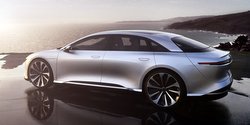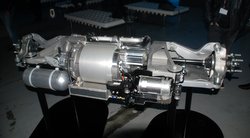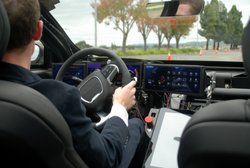Another SF Bay Area Start-up Touts Ground-up Design Aesthetic

Let’s cut to the chase–Is the world waiting for another expensive luxury electric car? Another San Francisco Bay Area start up, Lucid Motors, thinks so, and its 300-member team recently unveiled the car they expect to have on the market in early 2019 (they’ve said production would begin in late 2018). It’s an ambitious, over-the-top car in an understated package clearly aimed at the kind of early technology adopters who have helped build Tesla into the leader in the field.
The tease in mid-December for the assembled media was engaging. Zak Edson, Lucid Motors’ director of marketing, said he would introduce three new cars—a world-class sports car, a sublime luxury car and an efficient urban commuter. The twist was that all three of these were embodied in the Lucid Air.
Since it’s presented as “uncompromised luxury†and will offer 1,000 horsepower as well as a full suite of autonomous technology, a predicted price tag north of $100,000 for the Air is not unexpected. The promise, which is as has been heard from Tesla and other contenders in the segment, is that prices for later models will come down to the $65,000 range.
The First View of the Air

In person the Air is striking, but not as distinguished in design as might be expected for a car with its revolutionary intent. Derek Jenkins, Lucid’s vice president of design, is a veteran of Mazda,
Volkswagen and Audi. He introduced the design aesthetic as “minimalist.†From a distance, in my view, it could easily be taken as the next generation Audi or mistaken for Tesla’s upcoming Model 3 (which will precede it to the market and cost less than half of what the Air is projected to retail at. That could be an issue, but Lucid has quite a ways to go before it has to deal with it.
While a fully realized (the December 2016 demo cars were presented as “alpha†or early development model) model was shown to the media, production is not schedule to start at its Arizona plant until the end of 2018. Tweaks to its design could occur during the interim, but Lucid wants the focus on its interior.
The Interior Is the Key

That interior, CTO Peter Rawlinson said, finds its inspiration in the executive jet. Much time was spent at the introduction describing the luxurious accommodations possible in the back seat, clearly anticipating either a chauffeur or a fully autonomous driving experience. The former might indicate that China is envisioned as a key market for the Air. The latter anticipates that autonomous technology will progress as planned and be more accepted by the time the car is on the market. The Air will come with a “comprehensive sensor suite†of redundant autonomous technology so the car will be ready to move to full autonomy as soon as it’s legal.
As significant as the executive jet influence might be, what’s more important might the company executive’s description of the genesis of the project: “The company started with a battery and an idea.†Since batteries are the most significant part of an electric car (both because of their cost and role in propulsion), that’s the right place to start.
Talking ‘Bout a Revolution
The prismatic battery pack wasn’t the only thing developed in-house. The team has patents on its small (in size, not in power) electric motor, transmission and differential. Talking with team

members, it’s clear the sense of the company is that they are truly reinventing the automobile, taking full advantage of not only electric drive, but the other innovations they have come up with.
They took advantage of the fact that they were designing an electric car and weren’t constrained by the traditional three-box design of an engine compartment/passenger compartment and trunk. The final result is a car that is essentially a (large) interior with short overhangs, almost what could be described as a one-box design. That’s been seen in minivans, but never a midsize sedan. With the Air, other than the structure needed to crash protection, virtually all of the car is the interior compartment.
A Positive Step

The Air also was designed as an all-wheel-drive model, which is essential when you’re talking about trying to deliver 1000 horsepower to the ground. The oil-cooled integrated motor/transmission will deliver “world class power density,†according to Lucid’s powertrain engineer Dick Biskup. It’s all-aluminum suspension contributes to reduced unsprung weight, which enhances its performance. That performance was on display during the test rides (no media driving was allowed) during the introduction. Even with only roughly 600 horsepower on demand in the alpha models, the instant torque was enough to simulate an executive jet’s take off.
All-in-all, the Lucid Air represents a positive step in the development of the electric car. It seems to demonstrate that a clean sheet of paper approach can produce additional benefits and efficiencies in final automobile. The challenge now for Lucid is to take this concept into production and stake out a market that allows them to be a viable car company. Its competitor in the city next door, Tesla, is still struggling with that hurdle even while it moves toward producing its high-volume fourth model. At a minimum, it will be fun to watch and good for the industry.

6 thoughts on “News: Lucid Motors Introduces High-end Electric Car”